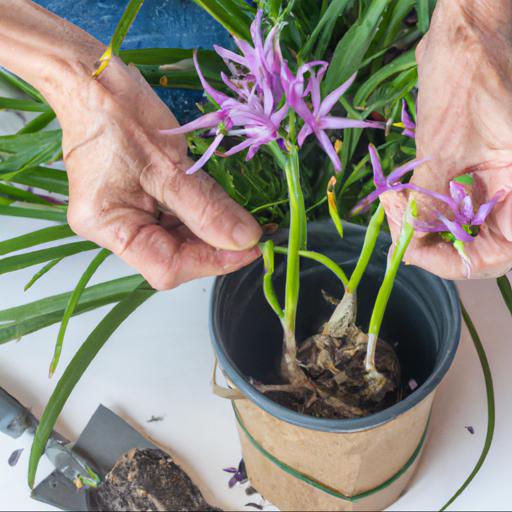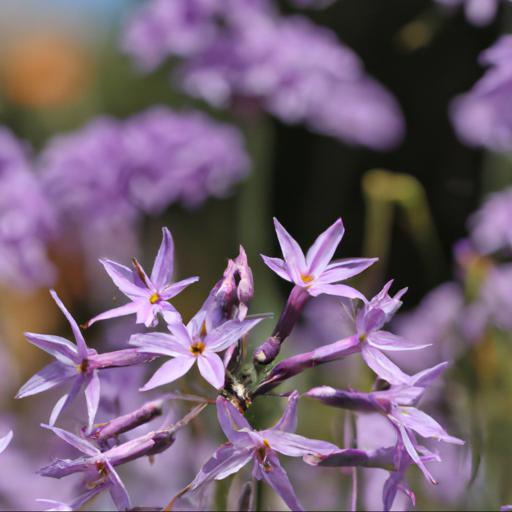Tulbaghia violacea, commonly known as society garlic, is an aromatic flowering perennial plant native to South Africa. It is an evergreen herb with a sweet, garlic-like scent that is often used in cooking and as an ornamental plant.
Society garlic has a long history of medicinal use and is known for its many health benefits. It is rich in vitamins and minerals, and its compounds have been found to have anti-inflammatory, anti-bacterial, and anti-fungal properties. Society garlic is also known for its ability to reduce blood pressure, improve circulation, and combat stress.
Its beautiful flowers and vibrant foliage make it an attractive addition to any garden.
Benefits of growing tulbaghia violacea

Gardening enthusiasts looking to add a unique touch of color and texture to their outdoor space should consider growing Tulbaghia violacea. The beautiful perennial is commonly known as Society Garlic and has a number of impressive benefits for gardeners. To begin with, Tulbaghia violacea is an unbelievably low-maintenance plant.
Society Garlic is extremely hardy and can thrive in even the most neglected or under-maintained areas of the garden. The plant has a rhizomatous growth habit which may require division every few seasons.
This is easily done with a sharp spade, making it a great choice for first-time gardeners. Another great advantage of Tulbaghia violacea is its impressive visual impact.
The plant produces tall stems of lightly scented, blooms that come in a variety of bright colors, such as lavender, pink, white, and lilac. The foliage is glossy and semi-evergreen, making it a great choice for even the shadiest of gardens. Finally, Society Garlic is popularly used as an ornamental border plant.
Its fragrant flowers make it an attractive choice for flower beds and rock gardens, while its dense clumps are attractive planted in large groupings at the back of a garden. For maximum impact, mix the plants with other shockers for a colorful and vibrant display.
Overall, Tulbaghia violacea is a well-rounded garden plant that is easy to care for and adds both color and fragrance to the outdoor space. Whether adding a few plants to create a beautiful border, or planting them en masse for a show-stopping display, Society Garlic is definitely worth considering for the garden.
How to plant and care for tulbaghia violacea

. Whether you’re an experienced gardener or a novice looking to start a garden, Tulbaghia violacea is a suitable plant for you. It is an easy-to-care-for perennial which will add a splash of colour to your garden.
Tulbaghia violacea is native to South Africa, and it produces clusters of pink and white star-shape blooms. The family of plants are often referred to as Society Garlic and the leaves have a distinctive garlic-like odour.
It likes sunny spots, sandy well-drained soils and it can be propagated by both cuttings and seed. As with many perennials it will slowly spread over time, and you might want to remove some of the older leaves each year to prevent it from becoming overcrowded. When it comes to caring for Tulbaghia Violacea, regular watering of the plant is essential; however, it can easily suffer from over-watering.
As it’s a perennial, it’s a low maintenance choice and doesn’t require much fertilizer or pruning. During the winter months, it’s best to mulch the soil around the base of the plant to protect its roots from freezing temperatures.
Finally, it’s important to give your plant some protection against slugs and snails – they can do a lot of damage to your hard work!
Common pests and diseases of tulbaghia violacea

Tulbaghia violacea, also known as the ‘Society Garlic’, is a flowering plant native to southern Africa, and is a popular ornamental plant throughout the world. As a hardy perennial it has become a favorite of gardeners because of its tolerance to a wide range of climates, and its attractive purple-pink flowers. But, as with any plant, it is susceptible to common garden pests and diseases, which can ruin its attractive flowers and foliage if not treated properly.
In this article, we will look at some of the most common problems facing Tulbaghia violacea, and advise on the best ways to control and prevent these issues. The most common pests for Tulbaghia violacea are aphids, mealybugs, and scale insects.
Aphids usually appear during the summer months, and can be seen clustering on the underside of leaves, leading to discoloration and yellowing of the foliage. Mealybugs can cause a white, waxy substance to cover the leaves of the plant, while scale insects are even more damaging, with infested plants forming honeydew and sooty mold on their foliage. The best way to control these pests is to remove them manually with a soft cloth or cotton swab, then use a natural insecticidal soap as a follow up treatment.
Another common problem facing Tulbaghia violacea is powdery mildew, which is a fungus that attacks the foliage of the plant. It forms a white powdery substance on the top of the leaves, and if left untreated it can lead to stunted growth and the death of the plant.
The best way to prevent powdery mildew from forming is to ensure that the plant has good air circulation, and to water from beneath the foliage rather than from above, as this helps to keep the plant dry. If powdery mildew does appear, it is best to treat it with a fungicidal spray as soon as possible.
Finally, Tulbaghia violacea is susceptible to root rot, which is caused by a fungus that lives in the soil. Symptoms include yellowing leaves and wilting, and eventually the death of the plant. The best way to prevent root rot is to make sure the soil is well-drained and contains plenty of organic matter, and to avoid overwatering.
If root rot does appear, remove any affected roots, then treat the plant with a fungicide. In conclusion, Tulbaghia violacea is a hardy perennial and a popular choice for gardeners, with beautiful purple-pink flowers and attractive foliage. However, it is susceptible to common garden pests and diseases, such as aphids, mealybugs, scale insects, powdery mildew, and root rot. In order to keep your Tulbaghia violacea healthy, it is important to monitor your plant for signs of these issues, remove any pests manually where possible, and use natural insecticidal soaps and fungicides to treat the affected areas.
Tips for growing tulbaghia violacea successfully
Tulbaghia violacea, also known as Society garlic, is an excellent addition to any garden. With its small white flowers and fragrant, garlic-scented foliage, it’s sure to bring a unique beauty to your garden setting.
But while it’s relatively easy to grow and maintain, it is important to understand some of the basics of successful Tulbaghia violacea growing. To start, Tulbaghia violacea prefers a well-draining soil, as it does not like to be over-watered. Make sure that you choose a soil mixture with some fine gravel or sand to help with drainage, and avoid soils that contain too much clay, as this can lead to water retention and root rot.
Plant your Tulbaghia violacea in an area that receives full sun, as this will help to ensure that the plant flowers abundantly. Additionally, Tulbaghia violacea appreciates regular pruning to help it stay healthy. Pruning should take place after the plant has finished flowering, as this will help to encourage new growth and improve the air circulation around the plant.
Be sure to remove dead and diseased foliage and any excess stems, as this will all help to keep the plant vigorous and in excellent condition. Finally, be sure to water your Tulbaghia violacea regularly – but don’t go overboard.
Over-watering can lead to root rot, so aim to keep the soil moist, rather than soggy. Also, if any signs of pest infestation appear, be sure to act quickly and use an appropriate natural insecticide to get rid of them. Following these tips will help ensure that your Tulbaghia violacea thrives in your garden.
Final Touch
Tulbaghia violacea, commonly known as Society Garlic, is a beautiful and fragrant flowering herb native to Southern Africa. It has many uses, from being a culinary herb to a medicinal ingredient.
It is also used in landscaping and is an attractive addition to any garden. Society Garlic is easy to grow, drought tolerant, and requires minimal care. It can be used as an ornamental plant, as a condiment, and for medicinal purposes.
With its attractive flowers and pleasant aroma, Society Garlic is a must-have for any garden.
FAQ
What are the common names for Tulbaghia violacea?
The common names for Tulbaghia violacea are Society Garlic, Pink Agapanthus, and Wild Garlic.
What are the medicinal uses of Tulbaghia violacea?
Tulbaghia violacea, also known as wild garlic, has a variety of medicinal uses. It is used to treat digestive issues, respiratory problems, skin conditions, and even cancer. It has anti-inflammatory, antimicrobial, and antioxidant properties, which make it useful for treating a variety of conditions. It is also used to boost the immune system, reduce fever, and improve circulation.
How is Tulbaghia violacea propagated?
Tulbaghia violacea is propagated by division of the rhizomes or by seed.
What is the ideal growing environment for Tulbaghia violacea?
The ideal growing environment for Tulbaghia violacea is full sun and well-drained soil with moderate to low water requirements.
What are the common pests and diseases of Tulbaghia violacea?
Common pests and diseases of Tulbaghia violacea include aphids, spider mites, powdery mildew, and root rot.
How often should Tulbaghia violacea be watered?
Tulbaghia violacea should be watered once a week, or when the soil is dry to the touch.

